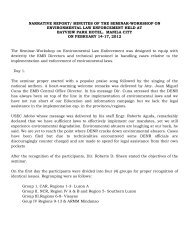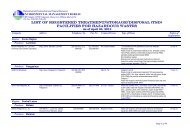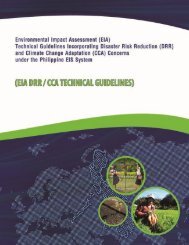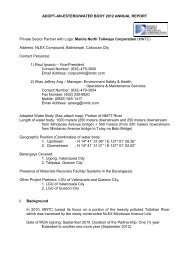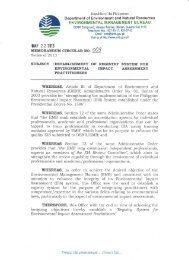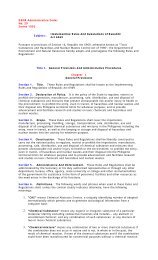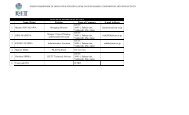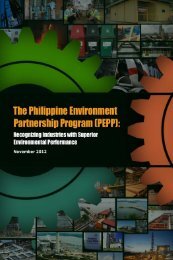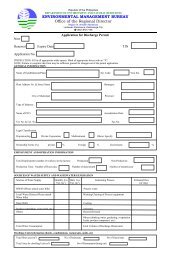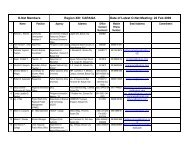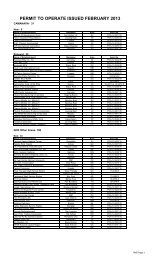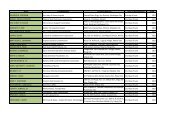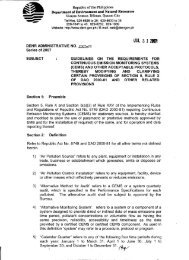DAO 2003-30 - Environmental Management Bureau
DAO 2003-30 - Environmental Management Bureau
DAO 2003-30 - Environmental Management Bureau
Create successful ePaper yourself
Turn your PDF publications into a flip-book with our unique Google optimized e-Paper software.
Republic of the PhilippinesDepartment of Environment and Natural ResourcesVisayas Avenue, Diliman, Quezon City, Philippines 1104DENR Administrative OrderNo. <strong>2003</strong>-<strong>30</strong>SUBJECT:Implementing Rules and Regulations (IRR) for thePhilippine <strong>Environmental</strong> Impact Statement (EIS)SystemConsistent with the continuing effort of the Department of Environment andNatural Resources (DENR) to rationalize and streamline the implementation ofthe Philippine <strong>Environmental</strong> Impact Statement (EIS) System established underPresidential Decree (PD) No. 1586, Presidential Proclamation No. 2146 definingthe scope of the EIS System and pursuant to Administrative Order No. 42 issuedby the Office of the President on November 2, 2002, the following rules andregulations are hereby promulgated;ARTICLE IBASIC POLICY, OPERATING PRINCIPLES, OBJECTIVES ANDDEFINITION OF TERMSSection 1.Basic Policy and Operating PrinciplesConsistent with the principles of sustainable development, it is the policy of theDENR to implement a systems-oriented and integrated approach to the EISsystem to ensure a rational balance between socio-economic development andenvironmental protection for the benefit of present and future generations.The following are the key operating principles in the implementation of thePhilippine EIS System:a. The EIS System is concerned primarily with assessing the direct andindirect impacts of a project on the biophysical and human environmentand ensuring that these impacts are addressed by appropriateenvironmental protection and enhancement measures.b. The EIS System aids proponents in incorporating environmentalconsiderations in planning their projects as well as in determining theenvironment’s impact on their project.
c. Project proponents are responsible for determining and disclosing allrelevant information necessary for a methodical assessment of theenvironmental impacts of their projects;d. The review of the EIS by EMB shall be guided by three general criteria:(1) that environmental considerations are integrated into the overallproject planning, (2) that the assessment is technically sound andproposed environmental mitigation measures are effective, and (3) thatsocial acceptability is based on informed public participation;e. Effective regulatory review of the EIS depends largely on timely, full, andaccurate disclosure of relevant information by project proponents andother stakeholders in the EIA process;f. The social acceptability of a project is a result of meaningful publicparticipation, which shall be assessed as part of the <strong>Environmental</strong>Compliance Certificate (ECC) application, based on concerns related tothe project’s environmental impacts;g. The timelines prescribed by this Order, within which an <strong>Environmental</strong>Compliance Certificate must be issued or denied, apply only to processesand actions within the <strong>Environmental</strong> <strong>Management</strong> <strong>Bureau</strong>’s (EMB)control and do not include actions or activities that are the responsibility ofthe proponent.Section 2.ObjectiveThe objective of this Administrative Order is to rationalize and streamline the EISSystem to make it more effective as a project planning and management tool by:a. Making the System more responsive to the demands and needs of theproject proponents and the various stakeholders;b. Clarifying the coverage of the System, and updating it to take intoconsideration industrial and technological innovations and trends;c. Standardizing requirements to ensure focus on critical environmentparameters;d. Simplifying procedures for processing ECC applications, and establishingmeasures to ensure adherence to ECC conditions by project proponents,ande. Assuring that critical environmental concerns are addressed duringproject development and implementation.Section 3.Definition of TermsFor the purpose of this Order, the following definitions shall be applied:a. Certificate of Non-Coverage – a certification issued by the EMB certifyingthat, based on the submitted project description, the project is not coveredby the EIS System and is not required to secure an ECC.2
. Co-located projects / undertakings – projects, or series of similar projectsor a project subdivided to several phases and/or stages by the sameproponent, located in contiguous areas.c. Environment – Surrounding air, water (both ground and surface), land,flora, fauna, humans and their interrelations.d. <strong>Environmental</strong> Compliance Certificate (ECC) - document issued by theDENR/EMB after a positive review of an ECC application, certifying thatbased on the representations of the proponent, the proposed project orundertaking will not cause significant negative environmental impact. TheECC also certifies that the proponent has complied with all therequirements of the EIS System and has committed to implement itsapproved <strong>Environmental</strong> <strong>Management</strong> Plan. The ECC contains specificmeasures and conditions that the project proponent has to undertakebefore and during the operation of a project, and in some cases, duringthe project’s abandonment phase to mitigate identified environmentalimpacts.e. <strong>Environmental</strong>ly Critical Area (ECA) - area delineated as environmentallysensitive such that significant environmental impacts are expected ifcertain types of proposed projects or programs are located, developed orimplemented in it.f. <strong>Environmental</strong>ly Critical Project (ECP) - project or program that has highpotential for significant negative environmental impact.g. <strong>Environmental</strong> Guarantee Fund (EGF) – fund to be set up by a projectproponent which shall be readily accessible and disbursable for theimmediate clean-up or rehabilitation of areas affected by damages in theenvironment and the resulting deterioration of environmental quality as adirect consequence of a project’s construction, operation or abandonment.It shall likewise be used to compensate parties and communities affectedby the negative impacts of the project, and to fund community-basedenvironment related projects including, but not limited to, information andeducation and emergency preparedness programs.h. <strong>Environmental</strong> Impact Assessment (EIA) – process that involvesevaluating and predicting the likely impacts of a project (includingcumulative impacts) on the environment during construction,commissioning, operation and abandonment. It also includes designingappropriate preventive, mitigating and enhancement measures addressingthese consequences to protect the environment and the community’swelfare. The process is undertaken by, among others, the projectproponent and/or EIA Consultant, EMB, a Review Committee, affectedcommunities and other stakeholders.3
i. <strong>Environmental</strong> Impact Assessment Consultant - a professional or group ofprofessionals commissioned by the proponent to prepare the EIS/IEE andother related documents. In some cases, the person or group referred tomay be the proponent’s technical staff.j. <strong>Environmental</strong> Impact Assessment Review Committee (EIARC) - a bodyof independent technical experts and professionals of known probity fromvarious fields organized by the EMB to evaluate the EIS and other relateddocuments and to make appropriate recommendations regarding theissuance or non-issuance of an ECC.k. <strong>Environmental</strong> Impact Statement (EIS) - document, prepared andsubmitted by the project proponent and/or EIA Consultant that serves asan application for an ECC. It is a comprehensive study of the significantimpacts of a project on the environment. It includes an <strong>Environmental</strong><strong>Management</strong> Plan/Program that the proponent will fund and implement toprotect the environment.l. <strong>Environmental</strong> <strong>Management</strong> Plan/Program (EMP) - section in the EIS thatdetails the prevention, mitigation, compensation, contingency andmonitoring measures to enhance positive impacts and minimize negativeimpacts and risks of a proposed project or undertaking. For operatingprojects, the EMP can also be derived from an EMS.m. <strong>Environmental</strong> <strong>Management</strong> Systems (EMS) - refers to the EMB PEPPEMS as provided for under <strong>DAO</strong> <strong>2003</strong>-14, which is a part of the overallmanagement system of a project or organization that includesenvironmental policy, organizational structure, planning activities,responsibilities, practices, procedures, processes and resources fordeveloping, implementing, achieving, reviewing and maintaining animproved overall environmental performance.n. <strong>Environmental</strong> Monitoring Fund (EMF) –fund that a proponent shall set upafter an ECC is issued for its project or undertaking, to be used to supportthe activities of the multi-partite monitoring team. It shall be immediatelyaccessible and easily disbursable.o. <strong>Environmental</strong> Performance – capability of proponents to mitigateenvironmental impacts of projects or programs.p. <strong>Environmental</strong> Performance Report and <strong>Management</strong> Plan (EPRMP) -documentation of the actual cumulative environmental impacts andeffectiveness of current measures for single projects that are alreadyoperating but without ECC's, i.e., Category A-3. For Category B-3 projects,a checklist form of the EPRMP would suffice.4
q. <strong>Environmental</strong> Risk Assessment (ERA) – assessment, through the use ofuniversally accepted and scientific methods, of risks associated with aproject. It focuses on determining the probability of occurrence ofaccidents and their magnitude (e.g. failure of containment or exposure tohazardous materials or situations.)r. EMS-based EMP - environmental management plan based on theenvironmental management system (EMS) standard as defined in the<strong>DAO</strong> <strong>2003</strong>-14.s. Initial <strong>Environmental</strong> Examination (IEE) Report - document similar to anEIS, but with reduced details and depth of assessment and discussion.t. Initial <strong>Environmental</strong> Examination (IEE) Checklist Report - simplifiedchecklist version of an IEE Report, prescribed by the DENR, to be filled upby a proponent to identify and assess a project’s environmental impactsand the mitigation/enhancement measures to address such impacts.u. Multipartite Monitoring Team (MMT) - community-based multi-sectoralteam organized for the purpose of monitoring the proponent’s compliancewith ECC conditions, EMP and applicable laws, rules and regulations.v. Programmatic <strong>Environmental</strong> Impact Statement (PEIS) - documentation ofcomprehensive studies on environmental baseline conditions of acontiguous area. It also includes an assessment of the carrying capacityof the area to absorb impacts from co-located projects such as those inindustrial estates or economic zones (ecozones).w. Programmatic <strong>Environmental</strong> Performance Report and <strong>Management</strong> Plan(PEPRMP) - documentation of actual cumulative environmental impacts ofco-located projects with proposals for expansion. The PEPRMP shouldalso describe the effectiveness of current environmental mitigationmeasures and plans for performance improvement.x. Project Description (PD) - document, which may also be a chapter in anEIS, that describes the nature, configuration, use of raw materials andnatural resources, production system, waste or pollution generation andcontrol and the activities of a proposed project. It includes a description ofthe use of human resources as well as activity timelines, during the preconstruction,construction, operation and abandonment phases. It is to beused for reviewing co-located and single projects under Category C, aswell as for Category D projects.y. Project or Undertaking - any activity, regardless of scale or magnitude,which may have significant impact on the environment.z. Proponent – any natural or juridical person intending to implement aproject or undertaking.5
aa. Public Participation – open, transparent, gender-sensitive, andcommunity-based process aimed at ensuring the social acceptability of aproject or undertaking, involving the broadest range of stakeholders,commencing at the earliest possible stage of project design anddevelopment and continuing until post-assessment monitoring.bb. Procedural Review – phase in the ECC application review process tocheck for the completeness the required documents, conducted by EIAMDivision at the EMB Central Office or Regional Office.cc. Process Industry – an industry whose project operation stage involveschemical, mechanical or other processes.dd. Scoping - the stage in the EIS System where information and projectimpact assessment requirements are established to provide the proponentand the stakeholders the scope of work and terms of reference for theEIS.ee. Secretary - the Secretary of the DENR.ff. Social Acceptability – acceptability of a project by affected communitiesbased on timely and informed participation in the EIA process particularlywith regard to environmental impacts that are of concern to them.gg. Stakeholders – entities who may be directly and significantly affected bythe project or undertaking.hh. Substantive Review – the phase in the EIA process whereby thedocument submitted is subjected to technical evaluation by the EIARC.ii. Technology – all the knowledge, products, processes, tools, methods andsystems employed in the creation of goods or providing services.ARTICLE IIECC APPLICATION PROCESSING AND APPROVALPROCEDURESSection 4.Scope of the EIS System6
4.1 In general, only projects that pose potential significant impact to theenvironment shall be required to secure ECC’s. In coordination with theDepartment of Trade and Industry (DTI) and other concerned governmentagencies, the EMB is authorized to update or make appropriate revisions to thetechnical guidelines for EIS System implementation.4.2 The issuance of ECC or CNC for a project under the EIS System does notexempt the proponent from securing other government permits and clearancesas required by other laws.In determining the scope of the EIS System, two factors are considered: (i) thenature of the project and its potential to cause significant negative environmentalimpacts, and (ii) the sensitivity or vulnerability of environmental resources in theproject area.4.3 The specific criteria for determining projects or undertakings to be coveredby the EIS System are as follows:a. Characteristics of the project or undertaking• Size of the project• Cumulative nature of impacts vis-à-vis other projects• Use of natural resources• Generation of waste and environment-related nuisance• Environment-related hazards and risk of accidentsb. Location of the Project• Vulnerability of the project area to disturbances due to its ecologicalimportance, endangered or protected status• Conformity of the proposed project to existing land use, based onapproved zoning or on national laws and regulations• Relative abundance, quality and regenerative capacity of naturalresources in the area, including the impact absorptive capacity of theenvironmentc. Nature of the potential impact• Geographic extent of the impact and size of affected population• Magnitude and complexity of the impact• Likelihood, duration, frequency, and reversibility of the impactThe following are the categories of projects/undertakings under the EIS system:Category A. <strong>Environmental</strong>ly Critical Projects (ECPs) withsignificant potential to cause negative environmental impacts7
Category B. Projects that are not categorized as ECPs, but whichmay cause negative environmental impacts because they arelocated in <strong>Environmental</strong>ly Critical Areas (ECA's)Category C. Projects intended to directly enhance environmentalquality or address existing environmental problems not fallingunder Category A or B.Category D. Projects unlikely to cause adverse environmentalimpacts.4.4 Proponents of co-located or single projects that fall under Category A andB are required to secure ECC. For co-located projects, the proponent has theoption to secure a Programmatic ECC. For ecozones, ECC application may beprogrammatic based on submission of a programmatic EIS, or locator-specificbased on submission of project EIS by each locator.4.5 Projects under Category C are required submit Project Description.4.6 Projects classified under Category D may secure a CNC. The EMB-DENR, however, may require such projects or undertakings to provide additionalenvironmental safeguards as it may deem necessary.4.7 Projects/undertakings introducing new technologies or constructiontechnique but which may cause significant negative environmental impacts shallbe required to submit a Project Description which will be used as basis by EMBfor screening the project and determining its category.Section 5. Requirements for Securing <strong>Environmental</strong> ComplianceCertificate (ECC) and Certificate of Non-Coverage (CNC)5.1 Documentary Requirements for ProponentsECC processing requirements shall focus on information needed to assesscritical environmental impacts of projects. Processing requirements shall becustomized based on the project categories.The following is a summary of the required documents, the processing,endorsing and deciding authorities for ECC/CNC applications and timeframe foreach project category:8
The total maximum processing time reckons from the acceptance of theECC/CNC application for substantive review up to the issuance of the decision5.2 Forms and Contents of EIA Study Reports and Other DocumentsRequired Under the EIS SystemThe following are the different forms of EIA study reports and documentsrequired under the EIS System. DENR employees are prohibited from taking partin the preparation of such documents.The DENR/EMB shall limit to a maximum of two (2) official requests (in writing) tothe project proponent for additional information, which shall be made within thefirst 75% of the processing timeframe shown in Section 5.1.1.5.2.1. <strong>Environmental</strong> Impact Statement (EIS).The EIS should contain at least the following:a. EIS Executive Summary;b. Project Description;c. Matrix of the scoping agreement identifying critical issues and concerns,as validated by EMB;d. Baseline environmental conditions focusing on the sectors (andresources) most significantly affected by the proposed action;e. Impact assessment focused on significant environmental impacts (inrelation to project construction/commissioning, operation anddecommissioning), taking into account cumulative impacts;f. <strong>Environmental</strong> Risk Assessment if determined by EMB as necessaryduring scoping;g. <strong>Environmental</strong> <strong>Management</strong> Program/Plan;h. Supporting documents, including technical/socio-economic dataused/generated; certificate of zoning viability and municipal land use plan;and proof of consultation with stakeholders;i. Proposals for <strong>Environmental</strong> Monitoring and Guarantee Funds includingjustification of amount, when required;j. Accountability statement of EIA consultants and the project proponent;andk. Other clearances and documents that may be determined and agreedupon during scoping.5.2.2. Initial <strong>Environmental</strong> Examination (IEE) Report9
IEE Report is similar to an EIS, but with reduced details of data and depth ofassessment and discussion.It may be customized for different types of projects under Category B. The EMBshall coordinate with relevant government agencies and the private sector tocustomize and update IEE Checklists to further streamline ECC processing,especially for small and medium enterprises.5.2.3. Programmatic <strong>Environmental</strong> Impact Statement (PEIS)The PEIS shall contain the following:a. Executive Summary;b. Project Description;c. Summary matrix of scoping agreements as validated by EMB;d. Eco-profiling of air, land, water, and relevant people aspects;e. <strong>Environmental</strong> carrying capacity analysis;f. <strong>Environmental</strong> Risk Assessment (if found necessary during scoping);g. <strong>Environmental</strong> <strong>Management</strong> Plan to include allocation scheme fordischarge of pollutants; criteria for acceptance of locators, environmentalmanagement guidebook for locators, and environmental liability scheme;h. Duties of the <strong>Environmental</strong> <strong>Management</strong> Unit to be created;i. Proposals for <strong>Environmental</strong> Monitoring & Guarantee Funds and terms ofreference for the Multi-partite Monitoring Team, andj. Other supporting documents and clearances that may be agreedduring the scoping.5.2.4. Programmatic <strong>Environmental</strong> Performance Report and<strong>Management</strong> Plan (PEPRMP).The PEPRMP shall contain the following:a. Project Description of the co-located projects;b. Documentation of the actual environmental performance based oncurrent/past environmental management measures implemented, andc. An EMP based on an environmental management system framework andstandard set by EMB.5.2.5. <strong>Environmental</strong> Performance Report and <strong>Management</strong> Plan(EPRMP) .The EPRMP shall contain the following:a. Project Description;b. Baseline conditions for critical environmental parameters;c. Documentation of the environmental performance based on thecurrent/past environmental management measures implemented;10
d. Detailed comparative description of the proposed project expansionand/or process modification with corresponding material and energybalances in the case of process industries, ande. EMP based on an environmental management system framework andstandard set by EMB.5.2.6. Project Description (PD)The PD shall be guided by the definition of terms and shall contain the following:a. Description of the project;b. Location and area covered;c. Capitalization and manpower requirement;d. For process industries, a listing of raw materials to be used, description ofthe process or manufacturing technology, type and volume of products anddischarges:e. For Category C projects, a detailed description on how environmentalefficiency and overall performance improvement will be attained, or howan existing environmental problem will be effectively solved or mitigatedby the project, andf. A detailed location map of the impacted site showing relevant features (e.g.slope, topography, human settlements).g. Timelines for construction and commissioning5.2.7. EMS-based EMP.The EMS-based EMP is an option that proponents may undertake in lieu of theEPRMP for single projects applying for ECC under Category A-3 and B-3.5.3 Public Hearing / Consultation RequirementsFor projects under Category A-1, the conduct of public hearing as part of the EISreview is mandatory unless otherwise determined by EMB. For all otherundertakings, a public hearing is not mandatory unless specifically required byEMB.Proponents should initiate public consultations early in order to ensure thatenvironmentally relevant concerns of stakeholders are taken into consideration inthe EIA study and the formulation of the management plan. All publicconsultations and public hearings conducted during the EIA process are to bedocumented. The public hearing/ consultation Process report shall be validatedby the EMB/EMB RD and shall constitute part of the records of the EIA process.5.4 Documentation Requirements for DENR-EMB and EIA Reviewers11
The EMB Central Office as well as the EMB Regional Offices shall document theproceedings of the ECC application process and shall set up and maintainrelevant information management systems. The documentation shall, at aminimum, include the following:5.4.1. Review Process ReportThis is to be prepared by the EMB Central or EMB RO. It is to be forwarded tothe DENR Secretary or RD as reference for decision-making and maintained aspart of the records on the ECC application. The report should contain at least thefollowing:a. Summary of the environmental impacts of the undertaking, along with theproposed mitigation and enhancement measures;b. Key issues/concerns and the proponent's response to these;c. Documentation of compliance with procedural requirements;d. Acceptability of proposed EMP including the corresponding cost ofmitigation, EGF and EMF if required;e. Key bases for the decision on the ECC application.5.4.2. EIARC ReportThis report, to be prepared by the EIA Review Committee, forms part of the EISreview documentation. The EIARC Report shall be written by the designatedmember of the EIARC and signed by all the members within five days after thefinal review meeting. If an EIARC member dissents, he or she must submit amemorandum to the EMB Director through the EIARC Chairman his or herreasons for dissenting.At a minimum the EIARC report should contain:a. Detailed assessment of the proposed mitigation and enhancementmeasures for the identified environmental impacts and risks;b. Description of residual or unavoidable environmental impacts despiteproposed mitigation measures;c. Documentation of compliance with technical/substantive review criteria;d. Key issues/concerns and the proponent's response to these, includingsocial acceptability measures;e. Assessment of the proposed EMP (including risk reduction/managementplan) and amounts proposed for the <strong>Environmental</strong> Guarantee Fund andthe <strong>Environmental</strong> Monitoring Fund, andf. Recommended decision regarding the ECC application as well asproposed ECC conditions.12
5.4.3. Decision DocumentThis is an official letter regarding the decision on the application. It may be in theform of an <strong>Environmental</strong> Compliance Certificate or a Denial Letter. The ECCshall contain the scope and limitations of the approved activities, as well asconditions to ensure compliance with the <strong>Environmental</strong> <strong>Management</strong> Plan. TheECC shall also specify the setting up of an EMF and EGF, if applicable. No ECCshall be released until the proponent has settled all liabilities, fines and otherobligations with DENR.A Denial Letter on the other hand shall specify the bases for the decision.The ECC or Denial Letter shall be issued directly to the project proponent or itsduly authorized representative, and receipt of the letter shall be properlydocumented.The ECC of a project not implemented within five years from its date of issuanceis deemed expired. The Proponent shall have to apply for a new ECC if it intendsto pursue the project. The reckoning date of project implementation is the date ofground breaking, based on the proponent’s work plan as submitted to the EMB.Section 6.AppealAny party aggrieved by the final decision on the ECC / CNC applications may,within 15 days from receipt of such decision, file an appeal on the followinggrounds:a. Grave abuse of discretion on the part of the deciding authority, orb. Serious errors in the review findings.The DENR may adopt alternative conflict/dispute resolution procedures as ameans to settle grievances between proponents and aggrieved parties to avertunnecessary legal action. Frivolous appeals shall not be countenanced.The proponent or any stakeholder may file an appeal to the following:Deciding AuthorityEMB Regional Office DirectorEMB Central Office DirectorDENR SecretaryWhere to file the appealOffice of the EMB DirectorOffice of the DENR SecretaryOffice of the President13
Section 7.The EIA Process in Relation to the Project Planning CycleProponents are directed under AO 42 to conduct simultaneously theenvironmental impact study and the project planning or feasibility study. EMBmay validate whether or not the EIS was integrated with project planning byrequiring relevant documentary proofs, such as the terms of reference for thefeasibility study and copies of the feasibility study report.The EMB shall study the potential application of EIA to policy-based undertakingsas a further step toward integrating and streamlining the EIS system.Section 8.EIS System Procedures8.1 Manual of Procedures8.1.1. The procedures to enable the processing of ECC/CNC applicationswithin the timeframes specified in AO 42 shall be prescribed in aProcedural Manual to be issued by the EMB Central Office within ninety(90) days from the date of this Order.8.1.2. The Manual of Procedures shall be updated as the need arises tocontinually shorten the review and approval/denial timeframes wherefeasible. Formulation of said procedures shall conform to the followingguidelines:8.2 Processing Timeframe8.2.1. If no decision is made within the specified timeframe, the ECC/CNCapplication is deemed automatically approved and the approvingauthority shall issue the ECC or CNC within five (5) working days afterthe prescribed processing timeframe has lapsed. However, the EMBmay deny issuance of ECC if the proponent fails to submit requiredadditional information critical to deciding on the ECC/CNC application,despite written request from EMB and despite an adequate period forthe proponent to comply with the said requirement;14
8.2.2. In cases where ECC issuance cannot be decided due to the proponent’sinability to submit required additional information within the prescribedperiod, the EMB shall return the application to the proponent. Theproject proponent may resubmit its application, including the requiredadditional information, within one (1) year for Category A projects andsix (6) months for Category B projects without having to pay processingand other fees. Otherwise, the matter shall be treated as a newapplication.8.2.3. In cases where EMB and the project proponent have exhausted allreasonable efforts to generate the information needed for deciding onthe ECC/CNC application, the responsible authority (Secretary or EMBDirector / Regional Director) shall make a decision based on theavailable information so as to comply with the prescribed timeframe. Thedecision shall nonetheless reflect a thorough assessment of impactstaking into consideration (i) the significance of environmental impactsand risks; (ii) the carrying capacity of the environment; (iii) equity issueswith respect to use of natural resources, (iv) and the proponent’scommitment to institute effective environmental management measures.8.3 Amending an ECCRequirements for processing ECC amendments shall depend on the nature of therequest but shall be focused on the information necessary to assess theenvironmental impact of such changes.8.3.1. Requests for minor changes to ECCs such as extension of deadlines forsubmission of post-ECC requirements shall be decided upon by theendorsing authority.8.3.2. Requests for major changes to ECCs shall be decided upon by thedeciding authority.8.3.3. For ECC’s issued pursuant to an IEE or IEE checklist, the processing ofthe amendment application shall not exceed thirty (<strong>30</strong>) working days;and for ECC’s issued pursuant to an EIS, the processing shall notexceed sixty (60) working days. Provisions on automatic approvalrelated to prescribed timeframes under AO 42 shall also apply for theprocessing of applications to amend ECC’s.15
Section 9.Monitoring of Projects with ECCsPost ECC monitoring of projects shall follow these guidelines. Other details onrequirements for monitoring of projects with ECC’s shall be stipulated in aprocedural manual to be formulated by EMB.9.1 Multipartite Monitoring TeamFor projects under Category A, a multi-partite monitoring team (MMT) shall beformed immediately after the issuance of an ECC. Proponents required toestablish an MMT shall put up an <strong>Environmental</strong> Monitoring Fund (EMF) not laterthan the initial construction phase of the project.The MMT shall be composed of representatives of the proponent and ofstakeholder groups, including representatives from concerned LGU's, locallyaccredited NGOs/POs, the community, concerned EMB Regional Office, relevantgovernment agencies, and other sectors that may be identified during thenegotiations. The team shall be tasked to undertake monitoring of compliancewith ECC conditions as well as the EMP. The MMT shall submit a semi-annualmonitoring report within January and July of each year.The EMB shall formulate guidelines for operationalizing area-based or clusterbasedMMT. The <strong>Bureau</strong> may also develop guidelines for delegating monitoringresponsibilities to other relevant government agencies as may be deemednecessary.For projects whose significant environmental impacts do not persist after theconstruction phase or whose impacts could be addressed through otherregulatory means or through the mandates of other government agencies, theoperations of MMT may be terminated immediately after construction or after areasonable period during implementation.9.2 Self-monitoring and Third Party AuditThe proponent shall also conduct regular self-monitoring of specific parametersindicated in the EMP through its environmental unit. The proponent’senvironmental unit shall submit a semi-annual monitoring report within Januaryand July of each year.For projects with ECCs issued based on a PEPRMP, EPRMP, or an EMS-basedEMP, a third party audit may be undertaken by a qualified environmental or EMSauditor upon the initiative of the proponent and in lieu of forming an MMT. Thesaid proponent shall submit to EMB a copy of the audit findings and shall be held16
accountable for the veracity of the report. The EMB may opt to validate the saidreport.9.3 <strong>Environmental</strong> Guarantee FundAn <strong>Environmental</strong> Guarantee Fund (EGF) shall be established for all co-locatedor single projects that have been determined by DENR to pose a significantpublic risk or where the project requires rehabilitation or restoration. An EGFCommittee shall be formed to manage the fund. It shall be composed ofrepresentatives from the EMB Central Office, EMB Regional Office, affectedcommunities, concerned LGU's, and relevant government agencies identified byEMB.An integrated MOA on the MMT-EMF-EGF shall be entered into among the EMBCentral Office, EMB Regional Office, the proponent, and representatives ofconcerned stakeholders.9.4 AbandonmentFor projects that shall no longer be pursued, the proponent should inform EMB torelieve the former from the requirement for continued compliance with the ECCconditions. For projects that have already commenced implementation, anabandonment/decommissioning plan shall be submitted for approval by EMB atleast six (6) months before the planned abandonment/decommissioning. Theimplementation of the plan shall be verified by EMB.ARTICLE IIISTRENGTHENING THE IMPLEMENTATION OF THE PHILIPPINEEIS SYSTEMSection 10.OrganizationsCoordination with other Government Agencies and otherThe DENR-EMB shall conduct regular consultations with DTI and other pertinentgovernment agencies, affected industry groups and other stakeholders oncontinually streamlining the processing of ECC applications and post ECCimplementation to fulfill the policy and objectives of this administrative order.The President shall be apprised of the issues raised as well as the actions takenby DENR to address these issues whenever necessary.Section 11.Information Systems Improvement17
The information system on the EIS System implementation shall be improved forthe effective dissemination of information to the public. The information systemshall include regular updating of the status of ECC applications through a websiteand through other means.Section 12.Accreditation SystemTo enhance the quality of the EIS submitted to the DENR/EMB, the EMB shallestablish an accreditation system for individual professionals, academic andprofessional organizations that can be tapped to train professionals in conductingEIA using training modules approved by EMB.The EMB shall also work with DTI-BPS for an accreditation system forenvironmental and EMS auditors, consistent with provisions of <strong>DAO</strong> <strong>2003</strong>-14 onthe Philippine <strong>Environmental</strong> Partnership Program.Section 13. Creation of an EIAM Division and Strengthening of Reviewand Monitoring CapabilityIn order to effectively implement the provisions of this administrative order, thecurrent EIA ad hoc division at the EMB Central Office and the EMB RegionalOffices that are primarily in-charge of processing ECC applications and post-ECC monitoring shall be converted to a full-pledged <strong>Environmental</strong> ImpactAssessment and <strong>Management</strong> Division (EIAMD). The Division shall have thefollowing structure and functions:13.1 The EIA Evaluation Section shall be in charge of screening projects forcoverage under the EIS System, EIS Scoping, and evaluation of EIS’s and IEE'ssubmitted for ECC issuance. It shall have three units responsible, respectively,for screening for coverage, EIS Scoping, and evaluation of ECC applications.The EMB may commission independent professionals, experts from theacademe and representatives from relevant government agencies as membersof the EIA Review Committee as may be deemed necessary. Further, continualimprovement of the technical capability of the Staff of the EIA Division shall beundertaken.13.2 The Impact Monitoring and Validation Section shall be in charge ofmonitoring compliance to ECC conditions and implementation of the<strong>Environmental</strong> <strong>Management</strong> Program (EMP). The unit shall also validate actualimpacts as a basis for evaluating environmental performance and effectivenessof the EMP.13.3 In the EMB Central Office, there shall be a Systems Planning and<strong>Management</strong> Section. It shall ensure that a continually improving systemsorientedand integrated approach is followed in implementing the Philippine EISSystem vis-a-vis national development programs. The section shall have twounits responsible for specific systems-level concerns: (1) Project Level Systems18
Planning and <strong>Management</strong> Unit; and (2) Program and Policy Level SystemsPlanning and <strong>Management</strong> Unit. This section shall also be responsible fortechnical coordination with the EIA Division in the different EMB RegionalOffices.The organizational structure of the EMB Central Office is in Annex 1.ARTICLE IVMISCELLANEOUS PROVISIONSSection 14.Budget AllocationFor the effective implementation of this order, adequate funding should beprovided under the annual General Appropriations Act.Per AO 42, the new position items for the EIA Division shall be created out of theexisting budget and vacant position items within the government service, whichshall be reclassified accordingly.Section 15.FeesAll proponents, upon submission of the IEE/EIS and application for amendment,shall pay filing fees and other charges in accordance with prescribed standardcosts and fees set by EMB in relation to the implementation of the Philippine EISSystem, as shown in Annex 2.The proponent shall shoulder the cost of reviewing the EIS.Section 16.Fines, Penalties And SanctionsThe EMB Central Office or Regional Office Directors shall impose penalties uponpersons or entities found violating provisions of P.D. 1586, and its ImplementingRules and Regulations. Details of the Fines and Penalty Structure shall becovered by a separate order.The EMB Director or the EMB-RD may issue a Cease and Desist Order (CDO)based on violations under the Philippine EIS System to prevent grave orirreparable damage to the environment. Such CDO shall be effectiveimmediately. An appeal or any motion seeking to lift the CDO shall not stay itseffectivity. However, the DENR shall act on such appeal or motion within ten (10)working days from filing.19
The EMB may publish the identities of firms that are in violation of the EIA Lawand its Implementing Rules and Regulations despite repeated Notices ofViolation and/or Cease and Desist Orders.Section 17.Transitory ProvisionsThe DENR may extend reprieve to proponents of projects operating without ECC(Categories A-3 and B-3) from penalties specified in PD 1586 upon registrationwith the EMB Central Office. An <strong>Environmental</strong> Performance Report and<strong>Management</strong> Plan (EPRMP) shall be submitted as a requirement for such ECCapplication within six months from the signing of this Administrative order.During the period that that the Procedural Manual and other necessaryguidelines are being prepared, existing guidelines which are consistent with theprovisions of this Order shall remain in effect. Adequate resources shall beprovided for the formulation of the Procedural Manual and for the effectiveimplementation of this Order.Section 18.Repealing ClauseThis Order hereby supersedes Department Administrative Order No. 96-37,Department Administrative Order No. 2000-37, <strong>DAO</strong> 2000-05 and other relatedorders, which are inconsistent herewith.Section 19.EffectivityThis Order shall take effect 15 days after its publication in a newspaper ofgeneral circulation.ELISEA G. GOZUNSecretary20



